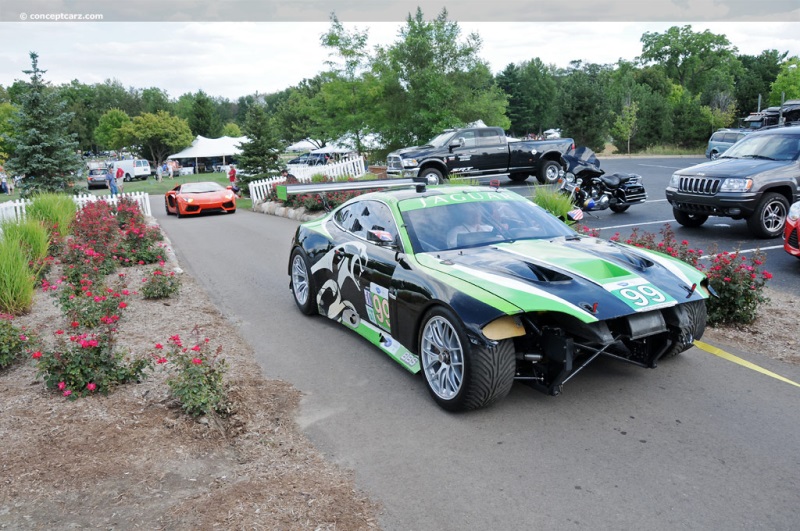


Coupe
There exists only two of these cars in the world, assembled and developed by the Gentilozzi family's RSR racing of East Lansing, MI. They competed in the 2010 24 hours of LeMans in the GT2 class, and have competed in the ALMS GT class against the C6R.
By the early 2000s, cars were evolving at an unprecedented pace. Every year manufacturers seemed to be eking out more power, more efficiency, and more performance, all backed up by more computers and more electronic driving aids. Emerging technologies were bundled into the automotive package, creating cars that could double as cell phones and MP3 players. Yet at the dawn of this technological revolution, Jaguar was out on a tea break. That proud jungle cat, the producer of some of the world's finest and most advanced sports cars in the 1950s and 1960s, had grown lazy and set in its ways under foreign (read: Ford) control.Ford was by no means incapable of running Jaguar well, and the American giant at least helped improve Jag's reputation for unreliability and poor quality control. The approach to running Jaguar was conservative, though, and aimed to keep a few traditionalists happy at the cost of potential new buyers. The advanced performance and styling that had once defined Jaguar had grown stale, leading to quaint caricatures of the brand's past legends. The XJ-series looked like the XJ-series always had—since 1968. The XK-series followed the controversially-styled XJS with a design that borrowed heavily from the original E-Type—of 1961. Jaguar had successfully established a model lineup that effectively looked 30 years behind the times.
Enter the 2005 Jaguar Advanced Lightweight Coupe concept, Ian Callum's ingenious interpretation of what a modern Jaguar should be. This concept, with refreshingly few changes, formed the basis for the Jaguar XK that would be released in 2006 for the 2007 model year.Though it retained enough design DNA to remain unmistakably Jag, the 2007 XK was a thoroughly modern car. Its design was many years ahead of the outgoing model's, styled by Callum with respect for Jaguar's past but eyes towards the brand's future. The Advanced Lightweight Coupe concept's name was well-founded, and its advanced and lightweight use of aluminum made it into the production XK. The production car was built on a remarkably rigid platform that used aluminum extrusions extensively to reduce weight and increase rigidity. The XK was designed from the beginning as a convertible (Ian Callum considered it easier to make a coupe of a convertible than the other way around), and that fact meant that the XK convertible not only looked as good as the coupe but was also impressively stiff. The XK debuted with a 4.2L, 32-valve V8 that made 300hp and was coupled with a 6-speed automatic transmission. The supercharged XKR version made 420hp. This was ample power for both cars, but, in an effort to keep up with the competition and avoid the problems witnessed at the outset of the millennium, Jaguar gave the XK and XKR brand new engines for 2010. With displacement increased to 5.0L, the new V8s now produce 385hp in naturally aspirated form and 510hp in supercharged guise.The XK, now complemented by the impressive XF and brand-new XJ, helped to revitalize Jaguar's ageing image. It represents the sporty car in Jag's small, cohesive lineup, and is a thoroughly modern piece that has earned the right to call itself by those two famous letters that first established Jaguar as a builder of benchmark sports cars in 1948.Sources:'2010 Jaguar XK / XKR Coupe and Convertible - Auto Shows.' Car and Driver Jan 2009: n. pag. Web. 15 Jul 2010. http://www.caranddriver.com/news/car/09q1/2010_jaguar_xk_xkr_coupe_and_convertible-auto_shows.
By Evan Acuña
That's not to say that Jaguar's cars weren't still beautiful—they were. But the design language had grown far too stale to attract new buyers, and, with dangerously low sales, change was needed to save the company from financial ruin.
MacKenzie, Angus. 'First Look: 200 Jaguar XK.' Motor Trend Oct 2005: n. pag. Web. 15 Jul 2010. http://www.motortrend.com/roadtests/coupes/112_0510_2007_jaguar_xk/index.html.
GT Vehicles
Similar Automakers
2011 Jaguar XKRS GT Vehicle Profiles
Recent Vehicle Additions
Related Automotive News

Audi of America announces pricing for the all-new 2017 R8, the fastest and most powerful Audi production model ever
More powerful and more dynamic than its predecessor, the R8 V10 plus generates 610 hp and 413 lb-ft of torque reaching a top track speed of 205 mph
The all-new Audi R8 and R8 LMS racecar were co-developed and share approximately 50 percent of the s...

CORVETTE ENGINE REPEATS WIN AS WARDSAUTO 10 BEST
6.2L LT1 among industrys elite powerplants
DETROIT – The high performance, technology-packed LT1 Small Block 6.2L V8 that powers the 2015 Corvette Stingray is a Wards 10 Best Engine for 2015. The engine also was recognized with this a...

CHEVROLET POWERS WAY TO PAIR OF ENGINE HONORS
DETROIT – The all-new, high-tech Small Block 6.2L V8 powering the 2014 Corvette Stingray and the 2.0L turbo diesel for the 2014 Chevrolet Cruze are among Wards 10 Best Engines.
WardsAuto reviewed 44 engines from 16 automakers in this years...

CHIP GANASSI RACING WITH FELIX SABATES SWITCHES TO FORD ECOBOOST POWER FOR 2014 UNITED SPORTSCAR CHAMPIONSHIP SEASON
bringing advanced technology of its 3.5-liter V6 EcoBoost® engine to racing in the 2014 TUDOR United SportsCar Championship
Chip Ganassi Racing with Felix Sabates switches to Fords powerful and efficient EcoBoost engines in pursuit of 8th champions...

ALL-NEW 2014 CORVETTE LT1 V-8 A TECHNOLOGICAL POWERHOUSE
Advanced technologies including direct injection, active fuel management, continuously variable valve timing support advanced combustion system
Preliminary output of 450 horsepower (335 kW) and 450 lb.-ft. of torque (610 Nm)
Helps deliver estima...







